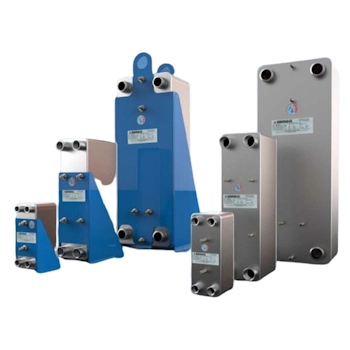Understanding how plate heat exchangers work is essential to grasp the energy efficiency and application potential of these devices in the industrial field. These are devices designed to transfer heat between two fluids without them ever coming into direct contact. The core of the exchanger consists of a series of corrugated metal plates, placed side by side and alternated to create distinct paths for each fluid, thus enabling rapid and efficient heat exchange.
Each plate is sealed with gaskets or welds, depending on the type of application, and their particular design promotes flow turbulence, improving heat transfer efficiency. To discover technical features and available models, you can visit the page dedicated to plate heat exchangers featured in the LubeTeam Hydraulic catalog.

Industrial Applications and Operational Advantages
Thanks to their flexibility and excellent performance, plate heat exchangers are used in numerous industrial sectors: from the food industry to chemicals, from HVAC to hydraulics. One of the most appreciated features is the ability to work with fluids of high or low viscosity, even under high pressure and temperature conditions.
The possibility to adapt the number and type of plates according to thermal requirements makes these exchangers particularly versatile. Moreover, the design with removable plates simplifies inspection, cleaning, and maintenance operations, reducing operational costs in the long term. The compactness of the system also makes them ideal for limited spaces or modular plants.
Energy Efficiency and Technological Innovation
One of the main advantages of plate heat exchangers is their high energy efficiency. Thanks to the turbulence induced by the shape of the plates and the proximity of the channels, the heat transfer coefficient is very high. This allows optimizing energy use and reducing waste, contributing to greater sustainability in production processes.
The most modern solutions integrate corrosion-resistant materials and advanced gaskets, designed to improve durability even in chemically aggressive environments. Some models are also designed to operate under extreme conditions, ensuring continuous reliability in critical applications.
In hydraulic and industrial fields, integrating plate exchangers with sensors and automated controls allows real-time monitoring of system efficiency, enabling timely interventions and smarter plant management.
Main Advantages in Summary
- High thermal efficiency thanks to the large exchange surface and turbulent fluid flow.
- Modularity and customization, with the possibility to configure the number and type of plates according to needs.
- Application versatility, suitable for numerous industrial sectors and different types of fluids.
- Reduced energy consumption compared to other heat exchange systems.
- Long operational life, thanks to the use of resistant materials and advanced technologies.
- Ease of cleaning, ideal for processes requiring high hygiene standards.
- Integration with sensors and monitoring systems for efficient and predictive management.

